Overview
Medicago sativa, also known as alfalfa or lucerne, is a plant in the family Fabaceae (the bean or pea family). This perennial legume is cultivated primarily as silage, hay, and grazing (as a fodder crop).
Besides being a fodder crop, it is a source of green manure, serves as a cover crop, humans eat its sprouts, and it is intercropped with crops like cotton to serve as an insectary.
Lucerne is nutrient-rich and a good source of proteins (including vital amino acids like threonine, lysine, and tryptophan), vitamins A, C and K, folate, manganese, thiamin, calcium, magnesium, selenium, riboflavin, copper, iron, β-carotene, and etcetera.
We already looked at as to whether rabbits can eat alfalfa or not. We will be focusing on alfalfa hay and bunnies, including the best brands to buy.
Can bunnies eat alfalfa hay?
Yes. Rabbits can eat alfalfa hay. However, like other legumes, including peas, clovers, and beans, it high in proteins, fats, calcium, and calories. Therefore, don’t feed it to healthy adult rabbits as a primary source of hay.
However, you can feed it to bunnies in the following categories:
- Baby buns above three weeks and growing youngsters up to seven months
- Sick and recovering bunnies including after surgery
- Those lactating and nursing
- Underweight or those with poor weight gain, i.e., it is ideal for fattening them.
- Skinny old rabbits without any history of calcium kidney and bladder stones.
- Rabbits raised for meat.
- Bunnies with long fur-like angora since they need more proteins.
Otherwise, it should only be an occasional small treat, including alfalfa-based pellets. Ideally, avoid giving it to your healthy mature adult bunnies aged a year and above.
In cases such as underweight, old, nursing, lactating, and so on, you have to mix it with other grassy hay and not give it alone. Your vet will guide you accordingly.
Finally, if alfalfa is only an ingredient of any bunny diet, it means the food is nutritionally balanced and safe for the specific bunny age group, breed, or size. Ensure you follow feeding instructions.
Best alfalfa hay for sale
Lucerne hay has flat green and few brown leaves with stems that may range from fine to coarse depending on the cut and when harvesting occurs.
Good quality hay should be:
- It should be fresh and sweet-smelling. Avoid brands that have a mushy or rusty odor.
- Should have minimal dust with a good ratio of leaves to stem.
- While the second cut is considered the best, the timing of the first, third, fourth, or fifth cut may affect its quality.
Some best brands to buy include the following:
1. Viking Farmer Alfalfa Hay for Rabbits & Small Pets
This fresh and all-natural Viking Farmer Alfalfa Hay should be your first choice if you have bunnies, chinchillas, or guinea pigs that need it. It is free of additives, preservatives, pesticides, weeds, GMO products, or other contaminants.
This brand by Viking Farmer undergoes careful handpicking and hand packaging to ensure you get not only the purest and greenest but also consistent quality with a good ratio of leaves to stems. Furthermore, the leaves will be intact and not twigs and dust.

Finally, nutritionally, it is high in fiber, vitamins, proteins, and other nutrients and it will ensure your pets have a shiny coat, improved digestion, and better teeth.
2. Kaytee Alfalfa Mini Bale Treat
The sun-cured Kaytee alfalfa mini bale is an excellent alternative to Vikings. It will support digestion, thanks to high fiber content, and will promote growth in growing bunnies since it is high in proteins and other nutrients.
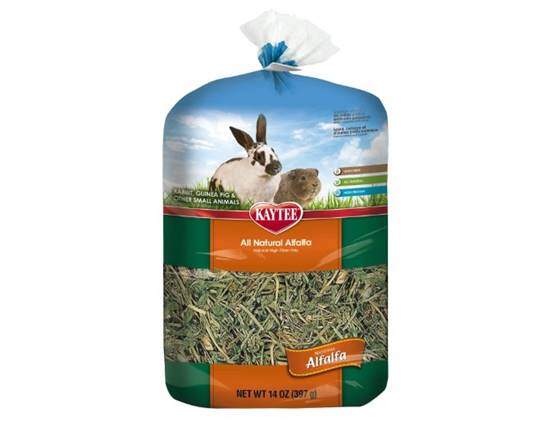
Furthermore, it doesn’t have any artificial additives, colors, or preservatives. While it is an excellent quality, there have been a few complaints about it being a little dusty with brown twig-like stems that have little or no leaves on them.
3. Oxbow Animal Health Alfalfa Hay for Pets
This premium lucerne hay from Oxbow is a superb select for any bunnies, chinchillas, or guinea pigs that require an energy-dense diet that is high in protein, calcium, and other nutrients such as lactating queens, growing bunnies, underweight or nursing ones. Give adult bunnies only a tiny pinch as a treat together with grassy hays and other foods.
It is free of preservatives or additives and comes in a mess-free packaging. Moreover, it has mostly leaves and stems with only a few seed heads.
Finally, it is high in fiber, has long-strands similar to those in grassy hay, and it is quite tasty. Your pets will like it.
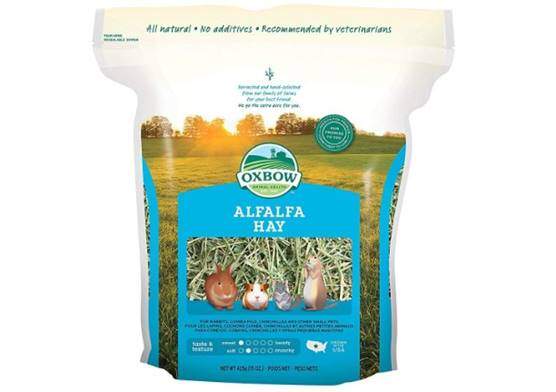
4. Rabbit Hole Hay Ultra-Premium, Hand Packed Alfalfa
Like other brands, Rabbit Hole Hay Ultra-Premium is high in proteins, vitamins, and minerals, making it essential in promoting growth in guinea pigs, rabbits, and chinchillas under the ages of six, seven and 12 months respectively. Transition to grassy hay like timothy when they grow beyond these ages.
Since it is hand-packed, it is of excellent quality, i.e., fresh, green, and sweet-smelling. If you buy it, you will no longer have to struggle with dusty brands as they are hard to feed to your pets and may cause respiratory diseases.
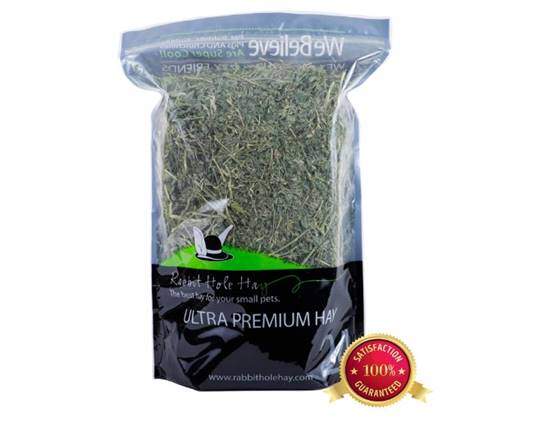
Finally, besides balanced nutrition, it has enough fiber to promote gut health. Most buyers are happy with their quality and price.
5. Small Pet Select Alfalfa Hay Pet Food
People with growing rabbits, guinea pigs, and chinchillas or those that are nursing or lactating, should also consider tasty and yummy Small Pet Select Alfalfa Hay Pet Food. It is high in protein, fiber, and other nutrients.
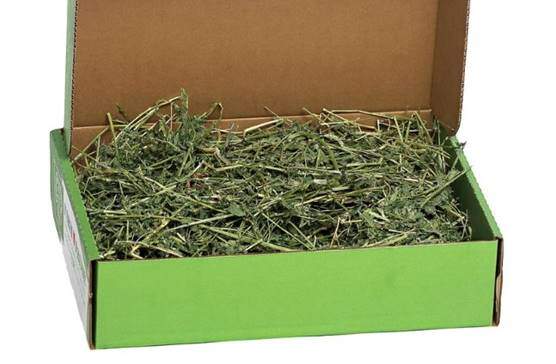
The high fiber will promote not only dental health but also a healthy gut keeping GI stasis and bloating at bay. Finally, it has a perfect stem to leaves ratio, and most bunnies will enjoy eating it, especially if served fresh.
6. Kaytee Alfalfa Cubes
If you prefer hay cubes, Kaytee has what you need. Unlike loose brands, their lucerne is compressed into blocks, meaning there will be less dust formation. Don’t confuse it with alfalfa pellets.
It is ideal for growing, lactating, or nursing animals since it is high in proteins, fiber, and other vital nutrients. Fiber is good for digestion as well as a healthy gut.
Finally, these cubes don’t have any artificial colors or preservatives, making them 100% safe for your pets.
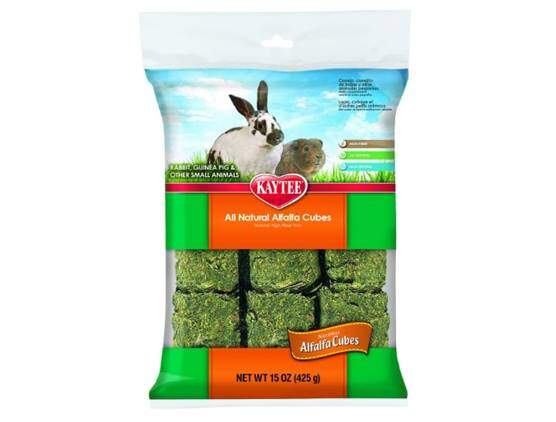
7. Grandpa’s Best Alfalfa Hay
Grandpa’s sun-cured alfalfa hay is a fresh, sweet, and a very palatable brand that comes in convenient, compact amounts of 15 oz., 40 oz., 5 lb. and 10 lbs. Don’t worry about additives or any preservatives as it doesn’t have any.
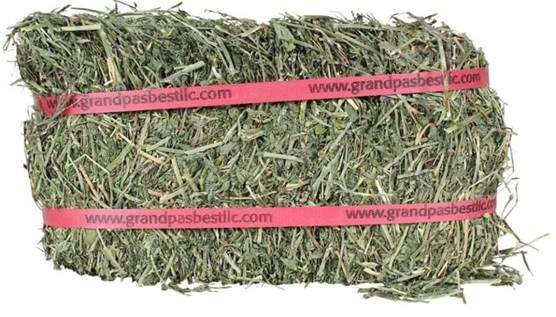
If you don’t like dusty brands, this is an excellent choice as it is handled minimally to reduce breakages and it is soft to use even as your pet’s bedding.
8. Other good brands
- Alfalfa King Double Compressed Alfalfa Hay Pet Food Treat
- Standlee Hay Company 1100-20010-0-0 Alfalfa Bale, 50 lbs.
Alfalfa vs. timothy hay
When compared to grassy hay like timothy, lucerne is more nutritious with higher crude protein (13-19% compared to 8-11%), higher in calcium (1.2-1.4% as opposed to 0.4-0.6%), is energy-dense, has more fats but slightly lower in fiber (28-34% vs. 32-34%).
Rabbits are very efficient in absorbing calcium, and they excrete excess amount via urine, a reason why you may notice them leaving a residue that is white and chalky if fed on this hay alone. This fact makes them prone to urinary stones (kidney and bladder stones or calcium sludge) if they eat foods high in calcium. Excess calcium may also have other health issues to this pet.
Secondly, it is energy-dense, increasing the likelihood of your bunnies ending up overweight or even obese.
While grass hay is lower in nutrients and calories, it is more balanced and will better meet your bunny’s nutritional needs.
Finally, it is common to find some brands of alfalfa hay mixed with other grassy hay at various percentages, especially orchard grass. As your vet, which brand will be ok.
Feeding alfalfa hay to baby rabbits aged 0-7 months
Kittens below three weeks should feed on only their mother’s milk or a Kitten Milk Replacement or other kitten milk formula if their mother isn’t there.
From 3-4 weeks, they can have mother’s milk as well as pellet and alfalfa nibbles. When aged between 4 and 7 weeks, allow them to have access to pellets and alfalfa hay on top of their mother’s milk.
From 7 weeks to 7 months, let them have unlimited alfalfa and pellets and begin weaning them off their mother’s milk at 8 weeks.
Finally, from 12 weeks onwards, begin it gradually introduce one vegetable at a time keeping the amount low, about half an oz.
Transitioning from alfalfa hay at seven months
At seven months, begin to transition from alfalfa hay to grassy hay timothy hay gradually. Keep pellets at to ½ cup per 6 pounds of body weight and progressively increase veggie mix up until it is about 2 packed cups per rabbit weighing 6 pounds as they get into mature adulthood.
You can also give them fruit, non-leafy veggies, and commercial treats. An ideal amount is 2 tablespoons per rabbit whose weight is six pounds.
Finally, bunnies will tend to prefer alfalfa to grassy hay. Therefore, when transitioning, always buy the best grassy hay brands like Small Pet Select 2nd Cutting “Perfect Blend” Timothy Hay Pet Food.
Should I go for first, second, or 3rd cut alfalfa?
Being a perennial plant, you can cut it up to five times. Which one should I buy?
1. First-cut lucerne
Most people consider it not suitable for their pets. However, this is not true if the cutting happens at the right time, i.e., before blooming (while still immature). However, it is higher in fiber, lower in protein and fats, making it ideal for bunnies that often suffer from GI stasis or if you want them to lose weight.
If you cut it after blooming, the stems will be larger and coarse, and it will have more lignin making it less palatable and less nutritious. However, some recent cultivars or varieties such as HarvXtra Alfalfa have less lignin.
Little into a biology class, lignin is an indigestible, non-carbohydrate compound in plant cell walls related to cellulose and hemicellulose. It is common in support and vascular plant tissues like bark and wood, and it is what makes them rigid.
2. Second cut
Second cut alfalfa is the best alfalfa hay for young rabbits as well as those nursing or lactating. It has more leaves on its stem. Also, the stems are finer and softer.
Furthermore, since more crude protein and non-structural carbs are in leaves, you expect it to have a little more crude protein, fats, and other nutrients while its fiber is lower.
However, if cut late, lignin levels will increase making it less nutritious and palatable while its fiber will go high.
3. Third cut
Third cut alfalfa is the most appealing. It looks soft and fluffy since it has fewer stems. Nutritionally, it has more nutrients and less fiber. Unless you mix with first and second cut alfalfa hay, it doesn’t have enough fiber for bunnies.
Storing it
Always store it in a cool, dry place that allows fresh air circulation since it does contain some moisture content, An airtight and sealed storage place will encourage mold growth.
Furthermore, don’t store it on direct sunlight, and discard any lucerne hay if it is moldy since molding causes toxins.
